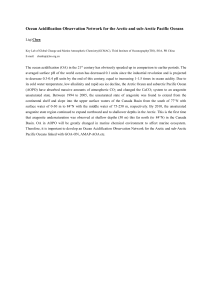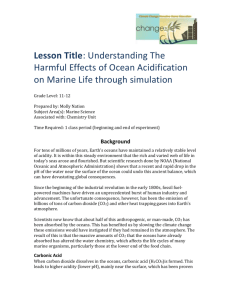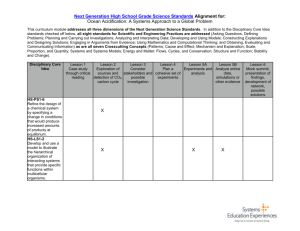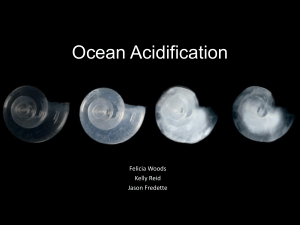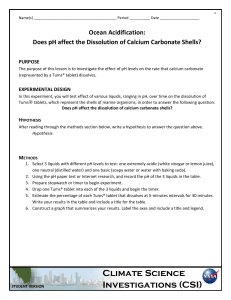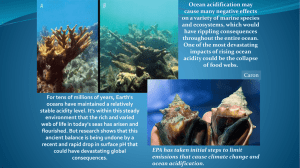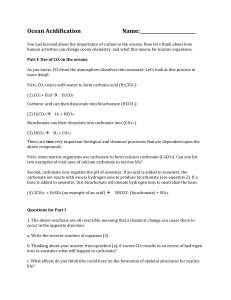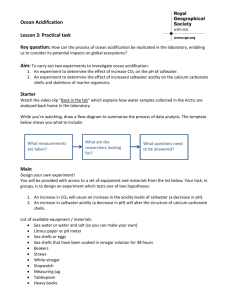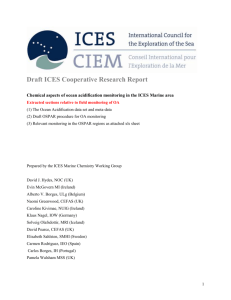Ocean acidification and eggshells
advertisement
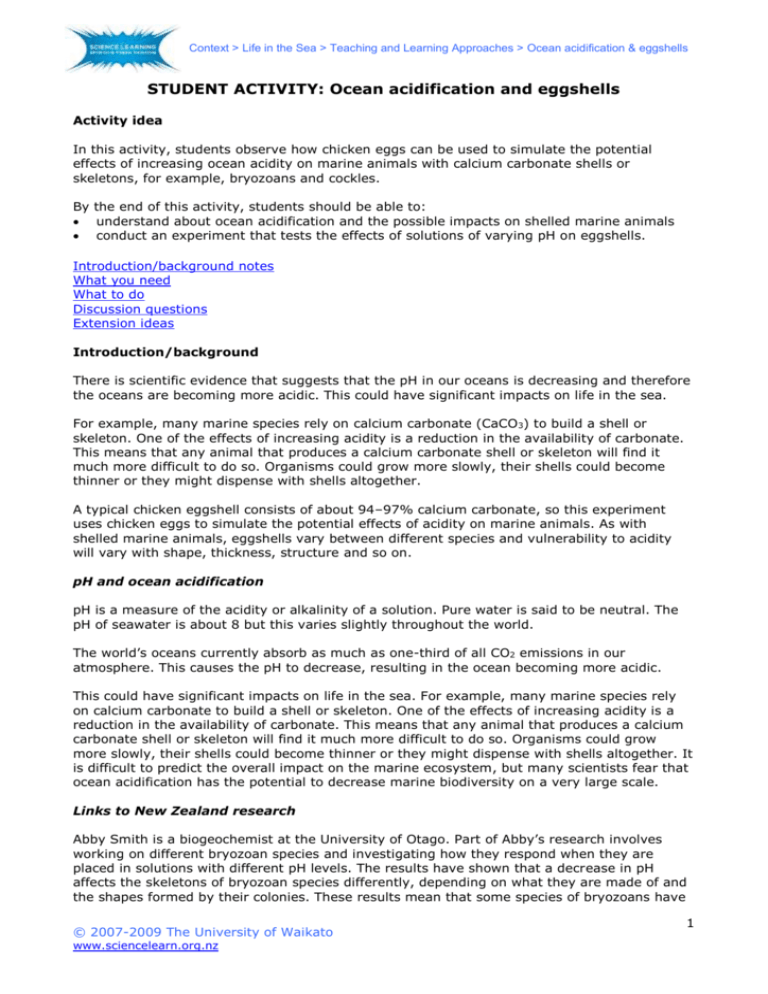
Context > Life in the Sea > Teaching and Learning Approaches > Ocean acidification & eggshells STUDENT ACTIVITY: Ocean acidification and eggshells Activity idea In this activity, students observe how chicken eggs can be used to simulate the potential effects of increasing ocean acidity on marine animals with calcium carbonate shells or skeletons, for example, bryozoans and cockles. By the end of this activity, students should be able to: understand about ocean acidification and the possible impacts on shelled marine animals conduct an experiment that tests the effects of solutions of varying pH on eggshells. Introduction/background notes What you need What to do Discussion questions Extension ideas Introduction/background There is scientific evidence that suggests that the pH in our oceans is decreasing and therefore the oceans are becoming more acidic. This could have significant impacts on life in the sea. For example, many marine species rely on calcium carbonate (CaCO3) to build a shell or skeleton. One of the effects of increasing acidity is a reduction in the availability of carbonate. This means that any animal that produces a calcium carbonate shell or skeleton will find it much more difficult to do so. Organisms could grow more slowly, their shells could become thinner or they might dispense with shells altogether. A typical chicken eggshell consists of about 94–97% calcium carbonate, so this experiment uses chicken eggs to simulate the potential effects of acidity on marine animals. As with shelled marine animals, eggshells vary between different species and vulnerability to acidity will vary with shape, thickness, structure and so on. pH and ocean acidification pH is a measure of the acidity or alkalinity of a solution. Pure water is said to be neutral. The pH of seawater is about 8 but this varies slightly throughout the world. The world’s oceans currently absorb as much as one-third of all CO2 emissions in our atmosphere. This causes the pH to decrease, resulting in the ocean becoming more acidic. This could have significant impacts on life in the sea. For example, many marine species rely on calcium carbonate to build a shell or skeleton. One of the effects of increasing acidity is a reduction in the availability of carbonate. This means that any animal that produces a calcium carbonate shell or skeleton will find it much more difficult to do so. Organisms could grow more slowly, their shells could become thinner or they might dispense with shells altogether. It is difficult to predict the overall impact on the marine ecosystem, but many scientists fear that ocean acidification has the potential to decrease marine biodiversity on a very large scale. Links to New Zealand research Abby Smith is a biogeochemist at the University of Otago. Part of Abby’s research involves working on different bryozoan species and investigating how they respond when they are placed in solutions with different pH levels. The results have shown that a decrease in pH affects the skeletons of bryozoan species differently, depending on what they are made of and the shapes formed by their colonies. These results mean that some species of bryozoans have © 2007-2009 The University of Waikato www.sciencelearn.org.nz 1 Context > Life in the Sea > Teaching and Learning Approaches > Ocean acidification & eggshells the potential to act as ‘canaries in the coal mine’ and provide early warning signs for areas that are at greatest risk from ocean acidification. What you need 3 eggs 3 beakers or clear glass jars with lids to avoid spills (container should have at least 300ml capacity) 250ml tap water 50ml vinegar 50ml household ammonia Note: The amount of liquid required may vary according to the size of container used. What to do 1. As a class, watch the video clip Ocean acidification. 2. As a class, make a list of all the marine animals you can think of that have shells or skeletons made of calcium carbonate (examples from this context include bryozoans, cockles and mussels). 3. Discuss the concept of pH and how this links to the oceans and life in the sea. 4. Set up and label 3 beakers: Acidic solution: 100ml tap water and 50ml vinegar Basic solution: 100ml tap water and 50ml household ammonia Neutral solution: 150ml tap water 5. Place 1 egg into each beaker (make sure the eggs are all the same size and from the same carton). Have students record any observations. 6. Leave the beakers in a cool area for 24 hours. Have students observe each beaker again and record any changes. 7. Repeat for up to 4 cycles. 8. Lift the eggs carefully out of the solutions. Invite the students to carefully touch the eggs. Have students record any differences: After approximately 72 hours, the eggs in the acidic solution will no longer have a shell. This is because the acetic acid in the vinegar dissolves calcium carbonate. When the acid reacts with the calcium carbonate, carbon dioxide is released, which causes the bubbles the students may have observed. Discussion questions What did you observe with the 3 different solutions? What did the acidic solution represent? How do you think ocean acidification might affect marine animals with shells? What about those with skeletons? How do you think ocean acidification might affect the marine food web? Is there anything we can do to reduce ocean acidification? Extension ideas Students could experiment with seashells or with different vinegar concentrations. © 2007-2009 The University of Waikato www.sciencelearn.org.nz 2
